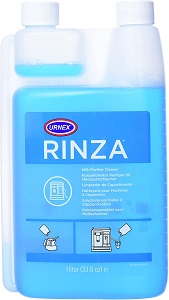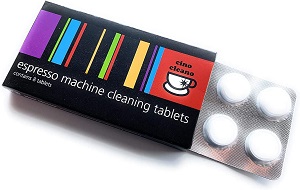You’ve shown yourself to be in the top few percent of espresso aficionados by purchasing an espresso machine that can make you the perfect cup of espresso anytime you want it. And you’ve spent your time to learn how to make that perfect drink.
But nothing can ruin that drink faster than a poorly maintained or poorly cleaned espresso machine. We find time spent caring for your machine to be very rewarding in the quality of the drinks produced.
Clean your machine regularly
Fortunately, newer espresso machines require less maintenance and have simplified cleaning compared to older machines. Also, your machine almost certainly has a reminder mechanism to tell you when maintenance procedures are required.
Removing the oily residue
Although it may not seem like it, coffee beans have quite a bit of oil in them. While these oils are critical to the taste and body of the coffee you are drinking, those same oils have a propensity for coating the workings of your machine and attracting other impurities. So, it is important to regularly clean the parts of your coffee maker that come in contact with the coffee beans or grounds.
Make sure to consult your owner’s manual for the best method of cleaning, including identification of parts like the brew head that can be removed for easy cleaning.
Cleaning the milk system
Cleaning your milk system of your espresso machine is an obvious no-brainer. You don’t want dry, stale milk to contaminate tomorrow’s drinks. Espresso machines typically have a way to purge the belt system easily with hot water from the espresso machine.
In addition to perjuring the milk system, there are several products for more aggressively cleaning the milk system. We generally use Rinza.

View Product on Amazon.com
Cleaning your grinder
First, try to avoid overly oily beans. As previously mentioned, the oil will go to cup your whole machine and most especially the grinder. Make sure you follow the grinder instructions for your machine and consider using a product like Supergrindz periodically to keep your grinder functioning perfectly.

View Product on Amazon.com
Descaling
All water contains some dissolved minerals. Over time, those minerals can deposit the scale on the water passages of your machine. One way to minimize scaling is to use distilled water for your drinks, although that can be more expensive and a bit of a hassle. Some filters will also work to reduce the minerals in your water. However, you should expect that some descaling will be required.
Newer machines will have an indicator to show you when descaling is needed. Since the scale is fundamentally limestone, it can actually be removed with vinegar–but it becomes difficult to remove the remaining vinegar odor and after-taste.
Again, read your owner’s manual. There are variety of products, often in the form of tablets, that you can run through your system to remove scale without leaving an aftertaste. For example, we use Cino Cleano tablets to descale our espresso machines.

View Product on Amazon.com
A clean machine will produce superb espresso; maintenance doesn’t take much time, but it makes your drink much better!